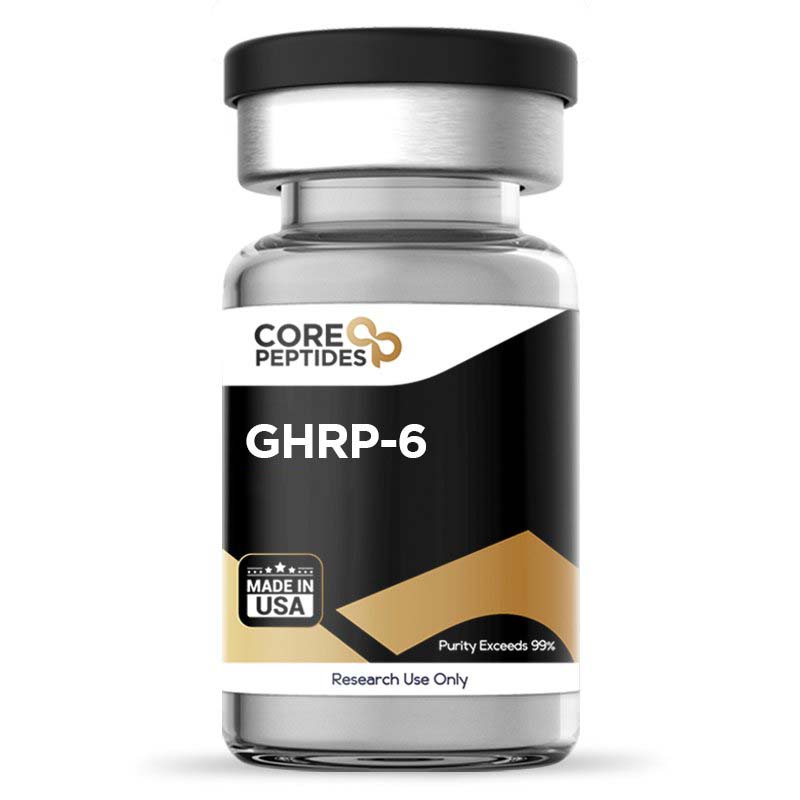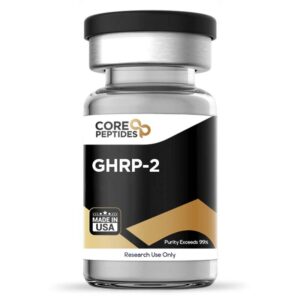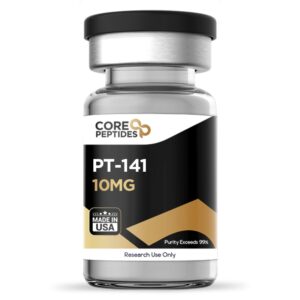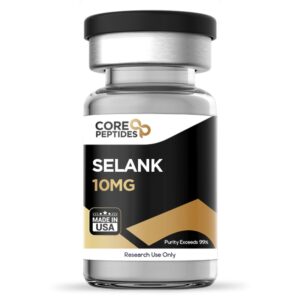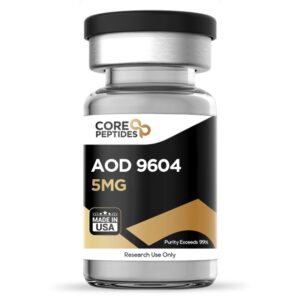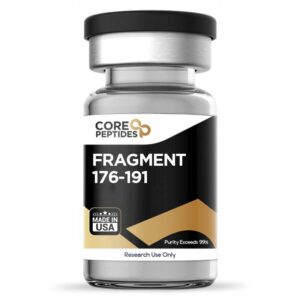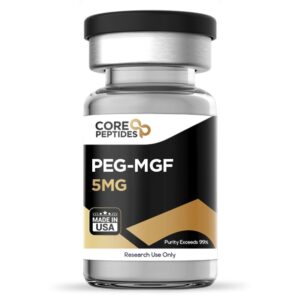GHRP-6 (5mg / 10mg)
$20.00 – $29.00
Size: 5mg / 10mg
Contents: GHRP-6
Form: Lyophilized powder
Purity: >99%
SKU: P-GHRP6
FREE Shipping on $200+ orders
Discount per Quantity
| Quantity | Discount | Price |
|---|---|---|
| 5 - 8 | 5% | $19.00 – $27.55 |
| 9 + | 10% | $18.00 – $26.10 |
GHRP-6 Peptide
Growth hormone releasing hexapeptide, or GHRP-6, belongs to a group of synthetic peptides developed with the potential to stimulate the secretion and regulate growth hormone levels. Similar to most such peptides, GHRP-6 is an analog of the naturally occurring opioid peptide and neuromediator called met-enkephalin. Yet, researchers suggest it may lack the opioid activity generally associated with these enkephalins.(1) Instead, GHRP-6 appears to interact with the so-called growth hormone secretagogue receptors (GHS-Rs) which eventually turn out to be ghrelin receptors. Thus, the peptide may also be defined as growth hormone secretagogue (GHS). It is a small, low molecular weight, synthetic peptide, which has been researched for its potential in growth hormone stimulation.(2)
Initially, growth hormone releasing peptides (GHRP) were developed with the intention of mimicking the mechanism of action of growth hormone releasing hormones (GHRHs). When GHRH was first isolated in 1984, scientists hypothesized that these compounds might operate differently; with GHRPs exhibiting an apparent affinity to bind with ghrelin receptors.(3) Ghrelin is also known as the hunger hormone, and it is naturally produced by the stomach when empty. Researchers suspected that GHRPs, like the endogenously found hormone ghrelin, may appear to govern action via hypothalamic stimulation and may have the potential to influence various functions, including metabolism and nutrient absorption.
Overview
Research was conducted to determine if GHRP-6 requires endogenous GHRH presence in order to exert its potential. In one study,(4) the researchers evaluated the impact of GHRP-6 exposure following either GHRH antagonist or saline presence in the research models. Blood samples were collected incrementally for the next few hours and the concentrations of growth hormones was measured. Following the study, the researchers suggested that hGH levels were lower in models presented with GHRH antagonist. They posited further that endogenous GHRH may be necessary for GHRP-6 to exert potential action.
While the mechanism of GHRP-6 remains under study,(4) further research studies have suggested that GHRPs may act by binding with two receptors, GHS-R1a, and CD36. In addition to hGH release, GHRP-6 also appears to have the potential to reduce cellular death through binding with CD36 receptors, possibly stimulating prosurvival cellular pathways.(2) This remains under investigation.
Earlier it was hypothesized that GHRP-6 may work through a double mechanism, producing possible activities at the pituitary gland and hypothalamus. In a study to investigate this mechanism of action,(5) two research model groups were evaluated, one group of hypothalamus-pituitary disconnection and one control model. Each subject was either presented GHRH, GHRP-6, or a combination of both. After presentation, the hGH levels were measured in all. In the control group, the highest levels of hGH were found in models given both GHRH and GHRP-6, followed by GHRP-6 models, and lastly the GHRH models. These results appeared to be converse in the research models of hypothalamic pituitary disconnection, with the least levels of HGH reported in those exposed to both GHRP-6 and GHRH. The GHRH subjects appeared to have the same levels of hGH as controls, whereas the hGH levels were reportedly reduced in models exposed to GHRP-6 alone. Two hypotheses were extended by the researchers from this study – first, GHRP-6 action may be induced primarily in the presence of GHRH and second, that GHRP-6 may act on hypothalamic pituitary axis in order to produce its potential.
Furthermore, researchers posited that GHRP-6 may potentially show an affinity toward CD36 receptors. These receptors are thought to fulfill various functions, such as possibly playing a part in lipid metabolism by acting as a scavenger receptor for lipids, aiding in their absorption, and possibly influencing immune responses by controlling phagocytosis and inflammation. The pathways involving CD36 might also have a role in the regulation of angiogenesis.(6)
Chemical Makeup
Molecular Formula: C46H56N12O6
Molecular Weight: 873.03 g/mol
Other Known Titles: Growth Hormone Releasing Peptide-6
Research and Clinical Studies
GHRP-6 Peptide and Hypothyroidism
Hypothyroidism is typically characterized by reduced levels of growth hormone secretion. The main aim of this study(7) was to determine whether GHRP-6, a supposed hGH release-stimulating agent, might be used to mitigate hGH level reduction. Research models of hypothyroidism were evaluated following random exposure to three different concentrations of GHRH, and GHRP-6. Following the completion of the study, it was observed by the researchers that the models exposed to GHRP-6 alone and with combination of GHRP-6 and GHRH appeared to induce significantly higher levels of growth hormones than GHRH alone. The possible reasoning behind this is that GHRP-6 may differ from GHRH, with the potential as a functional antagonist of somatostatin at the pituitary level, which may be potentially why GHRP-6 may exert possibly increased action on hypothyroidism compared to GHRH.
GHRP-6 Peptide and Cortisol Hormone Release
In this study,(8) the action of GHRP-6 peptide on the hormone release and sleep electroencephalogram (EEG) during the night time was studied. Research models were exposed with either the GHRP-6 peptide or a placebo. After the peptide, it was observed by the researchers that GHRP-6 appeared to induce higher secretion of both growth hormones and cortisol (ACTH) hormones. Throughout the night, particularly during the first half, cortisol hormone release and stage 2 sleep appeared to be enhanced, while the other sleep EEG variables remained apparently unchanged. This study suggested that not only may GHRP-6 possibly induce growth hormone release, but it also may act on the hypothalamus and pituitary gland axis, mobilizing cortisol hormone release.
GHRP-6 Peptide and Organ Function
The main goal of this study(9) was to determine the action of GHRP-6, either alone or in combination with epidermal growth factor (EGF), on multiple organ failure. The first iteration of this study was conducted on the experimental models of injury and multiple organ failure, while the second iteration of the study was conducted on rat intestine and colonic cancer cells. The first study suggested that GHRP-6 may impact the gut epithelial cells and increase cell migration by three times a control rate, without an apparent impact on cell proliferation. In the second model, multiple organ failure caused severe hepatic and intestinal damage and lipid peroxidation. Presentation of GHRP-6 appeared to reduce these damages by a reported 50-85%, with additional activity when GHRP-6 was presented in combination with EGF.
GHRP-6 Peptide and GI transit
The main aim of this study(10) was to investigate the potential of GHRP-6 on delayed gastrointestinal (GI) transit induced by diabetes. An experimental mouse model, with alloxan-induced diabetes, was used for this study. Alloxan is a synthetic uric acid derivative compound, commonly used for experiments, which induces diabetes upon presentation.(11) All experimental mice were presented with GHRP-6 at interval concentrations. Based on the study analysis, researchers posited that the diabetes appeared to reduce the levels of gastric emptying (GE), intestinal transit (IT) and colonic transit (CT) in mice. Upon GHRP-6 presentation, the levels of GE and IT reportedly improved, with no reported fluctuation in CT levels.
GHRP-6 Peptide and Neuroprotection
The peptide GHRP-6 has been associated by researchers with the safeguarding and restoration of nerve tissue. Research explored its impact on the IGF-1 (insulin-like growth factor-1) system within the brains of mouse models.(12) The potential benefits of GH, especially its apparent growth-promoting action, are often believed to be mediated via IGF-1. One study concentrated on the impact of peptides such as GHRP-6 on the brain's IGF-1 system. Results indicated that exposure to GHRP-6 for a week appeared to elevate IGF-1 mRNA levels in the hypothalamus, cerebellum, and hippocampus, but not in the cerebral cortex, suggesting that GH and GHRP-6 might enhance IGF-1 production in specific areas of the brain. The study also examined the expression of the IGF receptor and IGFBP-2, a protein that binds IGF, finding no notable changes in their activity following the introduction of the peptide. However, the phosphorylation of Akt and the Bcl-2-associated death promoter (BAD) was observed in areas with increased IGF-1 levels, indicating that GH and GHRP-6 may initiate cellular survival pathways in reaction to growth factors. Bcl-2-associated death promoter belongs to the Bcl-2 family of proteins, which is vital for cell death regulation, whereas Akt is a kinase that plays a role in various cellular processes including metabolism, apoptosis, growth, transcription, and migration. There were no observed alterations in MAPK or glycogen synthase kinase-3beta activity. The study noted an increase in the antiapoptotic protein Bcl-2 in areas with raised IGF-1, while the proapoptotic protein Bax levels remained consistent, hinting at a shift towards cell preservation over apoptosis. Lastly, IGFBP-5, linked with neuronal survival, showed significant elevation primarily in the hypothalamus, pointing to a potential neuroendocrine role.
GHRP-6 Peptide and Muscle Tissue
Some research suggests that GHRP-6 may exhibit anabolic capabilities, possibly through a presumed stimulation of growth hormone and IGF-1. An experiment involving cultured myoblast cells indicated that this peptide might enhance the production of myogenic marker proteins, insulin-like growth factor-1, collagen type I, and the metabolic processes within the myoblasts.(13) Therefore, the researchers inferred that GHRP-6 might potentially enhance muscle tissue by promoting the synthesis of collagen type I and crucial proteins.
GHRP-6 may also have anabolic potential through a possible stimulatory effect in GH synthesis, and consequently may induce a possible increase in IGF-1. GHRP-6 has been posited to potentially trigger GH release in a specific manner across multiple species which may be considerably greater than physiological GH synthesis by the anterior pituitary gland cells. To delve deeper into the mechanisms behind the potential of the peptide, a study experimented with both GHRP-6 and GHRH. The researchers commented that GHRP-6 apparently elicited a GH secretion with a peak of 15.7 ± 4.4 μg/L and an area under the curve (AUC) of 674 ± 187 μg/L/90mins. These figures appeared to be higher than those elicited by GHRH stimulation that mimics the natural synthesis, and led to an increase of 6.8 ± 1.1 μg/L for the peak and 412 ± 71 μg/L/90mins for the AUC, respectively.(14) Another similar study also reported an apparent GH peak of about 15.4 μg/L produced by the anterior pituitary cells, under the potential influence of GHRP-6, while the the physiological peak in GH levels was reported to have reached a maximum of just 5.5 μg/L.(15)
GHRP-6 Peptide and Tissue Recovery
As indicated, GHRP-6 is believed to stimulate not only ghrelin (GHS-Rs) receptors, which are linked to GH production, but also CD36 receptors, potentially mediating anti-inflammatory and other advantageous effects. A preclinical study involving murine models exposed to GHRP-6 for 30 days suggested a possibility for faster wound healing and diminished hypertrophic scar development by lessening inflammation and the expression of fibrotic cytokines, pointing to its potential utility in enhancing wound appearance.(16) Similarly, in a separate preclinical investigation, the stimulation of ghrelin receptors was posited to improve wound healing in rats subjected to combined radiation and burn injury, through a reduction in pro-inflammatory agents, particularly TNF-α, and the alteration of signaling pathways related to inflammation and healing.(17) Furthermore, it was reported that following 60 days of GHRP-6 exposure, there was a potential decrease in liver fibrosis and a reduction in fibrogenic factors such as TGF-β and CTGF, with fibrotic areas and nodularity decreasing by 75% and more than 60%, respectively.(18) This indicates the potential for GHRP-6 to possibly mitigate fibrosis and enhance the healing process in experimental settings.
GHRP-6 peptide is available for research and laboratory purposes only. Please review and adhere to our Terms and Conditions before ordering.
References:
- Rico M, Lorenzo MT, Pazo JA, Vega FV, De la Cruz LF. GHRP-6 in heifer and cow adenohypophisial cells separated by elutriation. J Physiol Biochem. 1999 Mar;55(1):33-9. PMID: 10494658.
- Berlanga-Acosta, Jorge et al. “Synthetic Growth Hormone-Releasing Peptides (GHRPs): A Historical Appraisal of the Evidences Supporting Their Cytoprotective Effects.” Clinical Medicine Insights. Cardiology vol. 11 1179546817694558. 2 Mar. 2017, doi:10.1177/1179546817694558. https://www.ncbi.nlm.nih.gov/pmc/articles/PMC5392015/
- Bowers, C.Y., et al (2012). Ghrelin: A history of its discovery. In Ghrelin in Health and Disaeas (pp. 1-35), Human press Inc. https://mayoclinic.pure.elsevier.com/en/publications/ghrelin-a-history-of-its-discovery
- Naushira Pandya, Roberta DeMott-Friberg, Cyril Y. Bowers, Ariel L. Barkan, Craig A. Jaffe, Growth Hormone (GH)-Releasing Peptide-6 Requires Endogenous Hypothalamic GH-Releasing Hormone for Maximal GH Stimulation, The Journal of Clinical Endocrinology & Metabolism, Volume 83, Issue 4, 1 April 1998, Pages 1186–1189. https://academic.oup.com/jcem/article-abstract/83/4/1186/2865313
- Popovic V, Damjanovic S, Micic D, Djurovic M, Dieguez C, Casanueva FF. Blocked growth hormone-releasing peptide (GHRP-6)-induced GH secretion and absence of the synergic action of GHRP-6 plus GH-releasing hormone in patients with hypothalamopituitary disconnection: evidence that GHRP-6 main action is exerted at the hypothalamic level. J Clin Endocrinol Metab. 1995 Mar;80(3):942-7. doi: 10.1210/jcem.80.3.7883854. PMID: 7883854. https://pubmed.ncbi.nlm.nih.gov/7883854/
- Demers, A., McNicoll, N., Febbraio, M., Servant, M., Marleau, S., Silverstein, R., & Ong, H. (2004). Identification of the growth hormone-releasing peptide binding site in CD36: a photoaffinity cross-linking study. The Biochemical journal, 382(Pt 2), 417–424. https://doi.org/10.1042/BJ20040036
- Pimentel-Filho FR, Ramos-Dias JC, Ninno FB, Façanha CF, Liberman B, Lengyel AM. Growth hormone responses to GH-releasing peptide (GHRP-6) in hypothyroidism. Clin Endocrinol (Oxf). 1997 Mar;46(3):295-300. doi: 10.1046/j.1365-2265.1997.1270942.x. https://pubmed.ncbi.nlm.nih.gov/9156038/
- Frieboes RM, Murck H, Maier P, Schier T, Holsboer F, Steiger A. Growth hormone-releasing peptide-6 stimulates sleep, growth hormone, ACTH and cortisol release in normal man. Neuroendocrinology. 1995 May;61(5):584-9. https://doi.org/10.1159/000126883
- Cibrián D, Ajamieh H, Berlanga J, León OS, Alba JS, Kim MJ, Marchbank T, Boyle JJ, Freyre F, Garcia Del Barco D, Lopez-Saura P, Guillen G, Ghosh S, Goodlad RA, Playford RJ. Use of growth-hormone-releasing peptide-6 (GHRP-6) for the prevention of multiple organ failure. Clin Sci (Lond). 2006 May;110(5):563-73. https://pubmed.ncbi.nlm.nih.gov/16417467/
- Zheng, Q., Qiu, W. C., Yan, J., Wang, W. G., Yu, S., Wang, Z. G., & Ai, K. X. (2008). Prokinetic effects of a ghrelin receptor agonist GHRP-6 in diabetic mice. World journal of gastroenterology, 14(30), 4795–4799. https://www.ncbi.nlm.nih.gov/pmc/articles/PMC2739343/
- Kristina Szabadfi, et al., Therapeutic Areas I: Central Nervous System, Pain, Metabolic Syndrome, Urology, Gastrointestinal and Cardiovascular, in Comprehensive Medicinal Chemistry II, 2007. https://www.sciencedirect.com/topics/medicine-and-dentistry/alloxan
- Frago LM, Pañeda C, Dickson SL, Hewson AK, Argente J, Chowen JA. Growth hormone (GH) and GH-releasing peptide-6 increase brain insulin-like growth factor-I expression and activate intracellular signaling pathways involved in neuroprotection. Endocrinology. 2002 Oct;143(10):4113-22. doi: 10.1210/en.2002-220261. PMID: 12239123.
- Lim, C. J., Jeon, J. E., Jeong, S. K., Yoon, S. J., Kwon, S. D., Lim, J., Park, K., Kim, D. Y., Ahn, J. K., & Kim, B. W. (2015). Growth hormone-releasing peptide-biotin conjugate stimulates myocytes differentiation through insulin-like growth factor-1 and collagen type I. BMB reports, 48(9), 501–506. https://doi.org/10.5483/bmbrep.2015.48.9.258
- Cordido, F., Peñalva, A., Dieguez, C., & Casanueva, F. F. (1993). Massive growth hormone (GH) discharge in obese subjects after the combined administration of GH-releasing hormone and GHRP-6: evidence for a marked somatotroph secretory capability in obesity. The Journal of clinical endocrinology and metabolism, 76(4), 819–823. https://doi.org/10.1210/jcem.76.4.8473389
- Frieboes, R. M., Murck, H., Maier, P., Schier, T., Holsboer, F., & Steiger, A. (1995). Growth hormone-releasing peptide-6 stimulates sleep, growth hormone, ACTH and cortisol release in normal man. Neuroendocrinology, 61(5), 584–589. https://doi.org/10.1159/000126883
- Mendoza Marí, Y., Fernández Mayola, M., Aguilera Barreto, A., García Ojalvo, A., Bermúdez Alvarez, Y., Mir Benítez, A. J., & Berlanga Acosta, J. (2016). Growth Hormone-Releasing Peptide 6 Enhances the Healing Process and Improves the Esthetic Outcome of the Wounds. Plastic surgery international, 2016, 4361702. https://doi.org/10.1155/2016/4361702
- Liu, C., Huang, J., Li, H., Yang, Z., Zeng, Y., Liu, J., Hao, Y., & Li, R. (2016). Ghrelin accelerates wound healing through GHS-R1a-mediated MAPK-NF-κB/GR signaling pathways in combined radiation and burn injury in rats. Scientific reports, 6, 27499. https://doi.org/10.1038/srep27499
- Berlanga-Acosta, J., Vázquez-Blomquist, D., Cibrián, D., Mendoza, Y., Ochagavía, M. E., Miranda, J., ... & Guillén-Nieto, G. E. (2012). Growth Hormone Releasing Peptide 6 (GHRP6) reduces liver fibrosis in CCl4 chronically intoxicated rats. Biotecnología Aplicada, 29(2), 60-72.
